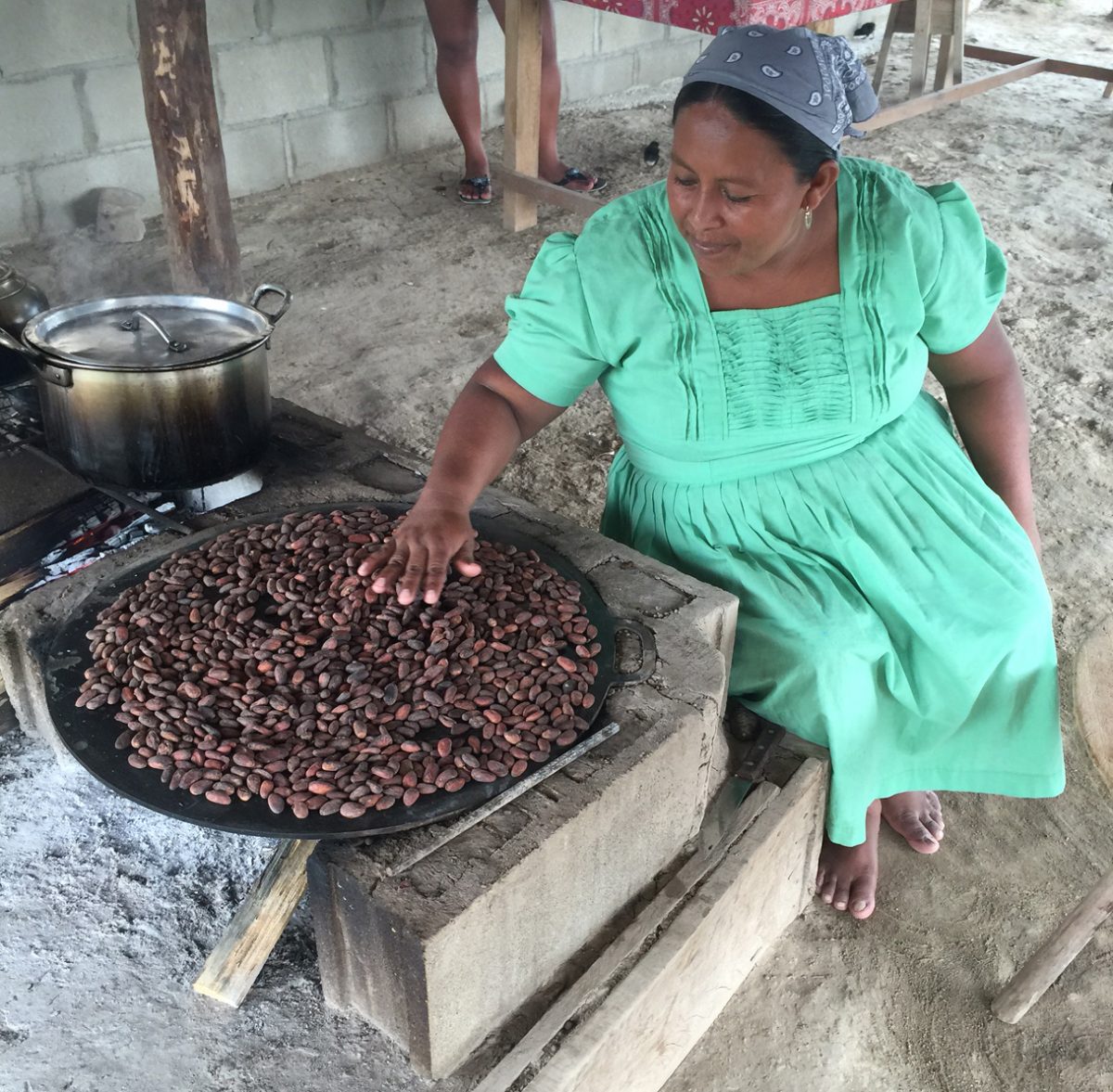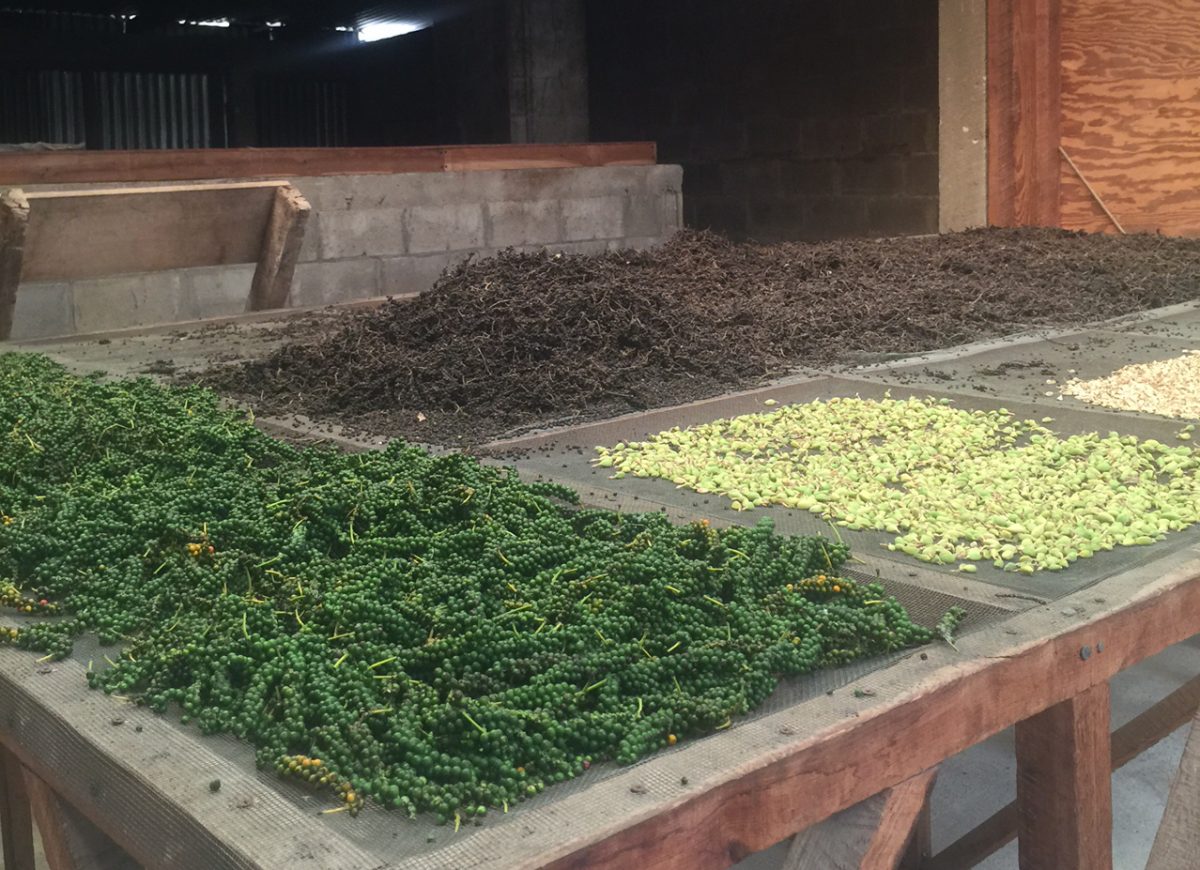“THE CRADLE OF CHOCOLATE” … SOUNDS GOOD TO US!
Money may not grow on trees, but chocolate does. More specifically, cacao does – in Belize.
We recently visited Maya Beach Hotel and Bistro, a charming 10-room boutique hotel on the Placencia Peninsula, just steps from the Caribbean Sea.

As part of the hotel’s new Chocolate & Spice Experience (which also includes a selection of cacao-infused dishes and cocktails from the hotel’s acclaimed Bistro) we were treated to a tour of southern Belize, “The Cradle of Chocolate.” We were lucky enough to spend a day learning to make chocolate at an organic cacao farm, and then touring and tasting our way through a spice farm. (As a food-related bonus, we also enjoyed Nim Li Punit, where we ogled and sampled the wild avocados and cilantro – or, as Mayans call it, colantro – that have grown around the famous Mayan ruins for thousands of years.)
When we arrived at the chocolate farm, we were greeted by the Mayan family – a couple and their 15(!) children – who worked the land and lovingly made the chocolate by hand using classic techniques passed down through generations. As we snacked on organic bananas picked fresh from the farm, we were led to the family’s outdoor kitchen. Italia, the eldest daughter, began our lesson by cracking open a cacao fruit, picked fresh, right in front of us. We were invited to pull out one of the pod’s slimy seeds, and suck the sweet, white, gelatinous substance from it. These seeds are actually the cacao beans.

We were also given raw, roasted, and fermented dark and white cacao beans to sample. The raw dark beans tasted like bitter dark chocolate, smooth but firm on the inside. The white beans were more nutty, and the roasted beans had a milder chocolate flavor. The fermented beans (made by soaking them in sugar water for extended periods of time) were best for chocolate bars, she explained.
Italia had a batch of recently picked and dried beans roasting – with fresh allspice, also grown by the family – when we arrived. She demonstrated how they should be consistently stirred by hand to avoid burning.

After they roasted for about 30 minutes, she pulled them off the pan, and crushed them with a rock to quickly remove the shells; then, we all tried our hand at de-shelling.

After the beans were crushed, she brushed them all into a large bowl, and began shaking it until the lightweight shells flew out, and only the crushed cacao nibs remained.

Italia then moved the crushed beans to a large grinding stone, made from volcanic rock and passed down to her from her mother – the most recent matriarch to receive the tool that has been utilized by four generations over the course of more than a century and a half.

She ground the beans on the stone with a smaller rock, until a liquid paste – pure dark chocolate – began to pool at the edge of the stone.

We all tried our hands at it as well (talk about an arm workout!). When the beans had been fully ground, Italia took the paste, placed it in a large gourd, and mixed it with hot water to make a traditional Mayan chocolate drink, called “Cacao Uk.” While we sipped it from smaller gourd cups, she explained that the drink has been used since the dawn of the Mayan empire to sustain the people as they worked the land, and raised their families. The antioxidants and natural energizing properties the beans possess are critical to ensuring one’s health when harvesting and planting, nursing a child and fighting illness.

Italia then demonstrated how the cacao paste was mixed with honey, milk, ginger, coconut, chile and other ingredients to make various types of pure chocolate bars. Naturally, we had to sample them all. This proved to be enough to sustain us until we reached the spice farm.

The Belize Spice Farm is an organic citrus and spice planation, not far from the chocolate farm. As we walked to the fields with our guides upon arrival, we snacked on oranges fresh off the trees, and were grateful everyone was so eager to feed us at every stop! We meandered through just a fraction of the hundreds of acres the farm encompasses, and saw and learned first-hand how spices such as black pepper, cardamom, nutmeg, cloves, cinnamon and vanilla are cultivated and cared for. We also saw (and sometimes sampled) coffee, more cacao, peppers, bananas, lemongrass and a variety of herbs. We then visited the farm’s pungent drying room, and sipped on freshly squeezed fruit juice.

Throughout the tour, our guides explained how pests are warded off without the use of chemical pesticides (by making an herbal ant-deterring tea from a local leaf), and demonstrated the pollination process of multiple plants. They also taught us that cardamom grows best under mango trees (it likes the shade they provide); vanilla takes nearly a year from the time the vine first flowers until the mature beans are ready to be enjoyed; black and white peppercorns come from the same plant, but are prepared differently; and cinnamon is actually bark – but the cinnamon tree leaves can also be chewed, like gum, and the flavor enjoyed more mildly that way.

We left the farm and headed back to Maya Beach, feeling full and much more educated about the agricultural – and culinary traditions – of this small, but delicious country. Just as everyone before them had, the Bistro team made sure we were we well fed that night at dinner – recommending the Cacao-Spice Martini, Cacao Pork and Chocolate Souffle, which we happily accepted, with a new appreciation.
The next day, we continued our culinary journey and dined on the red snapper we caught that afternoon, after an awe-inspiring snorkeling adventure at a nearby reef, with a local fisherman. As was everything the award-winning restaurant produced, it was prepared for us, perfectly, at Maya Beach Bistro.

